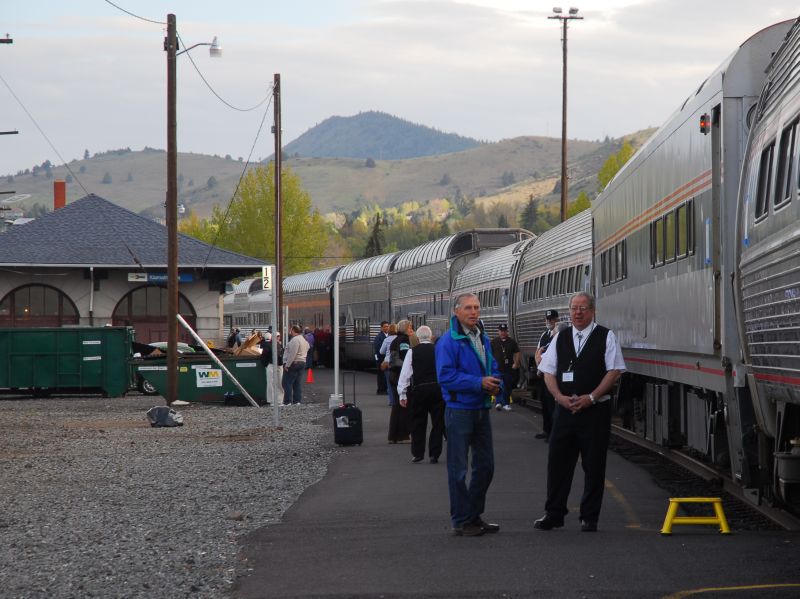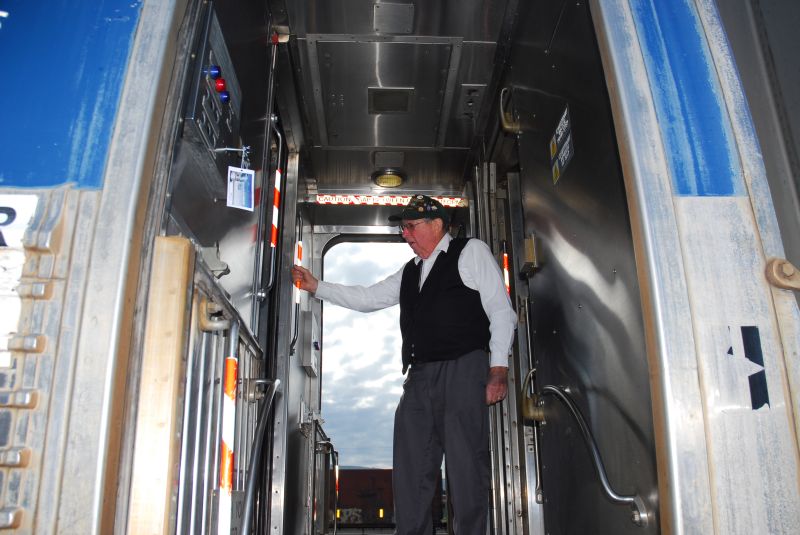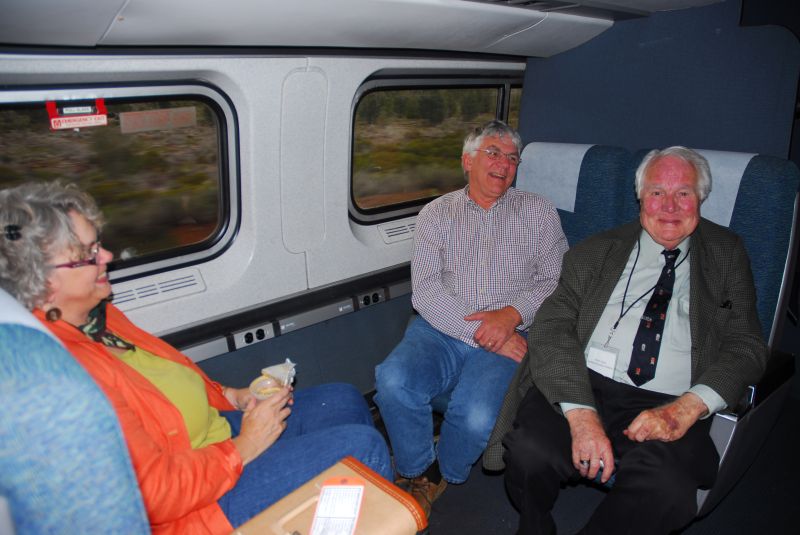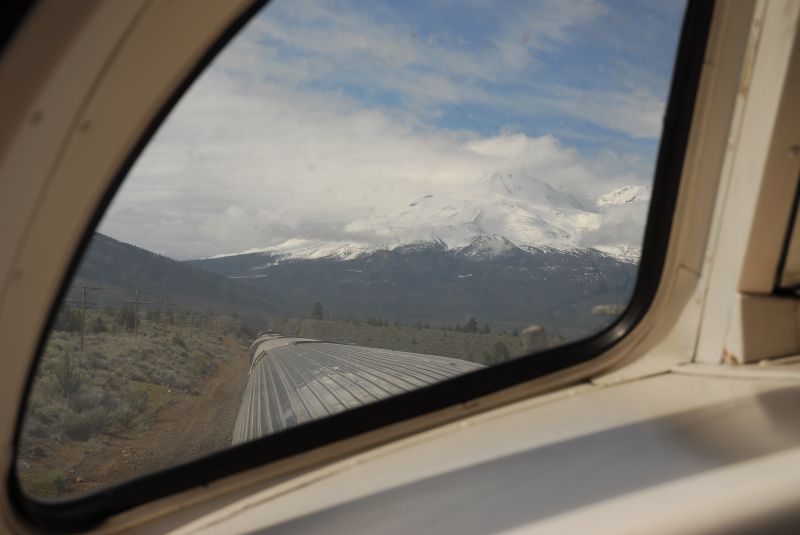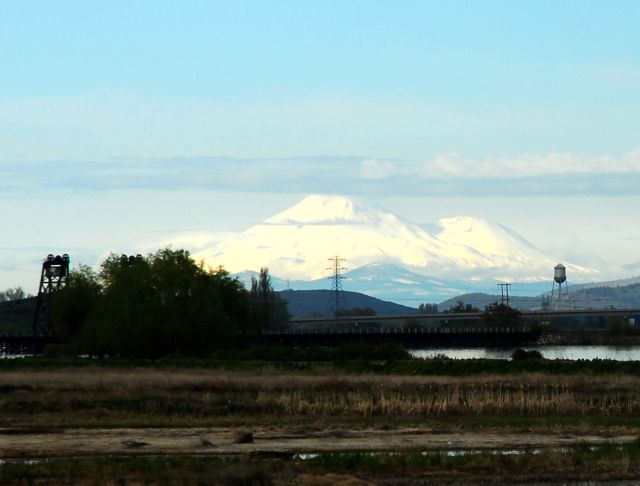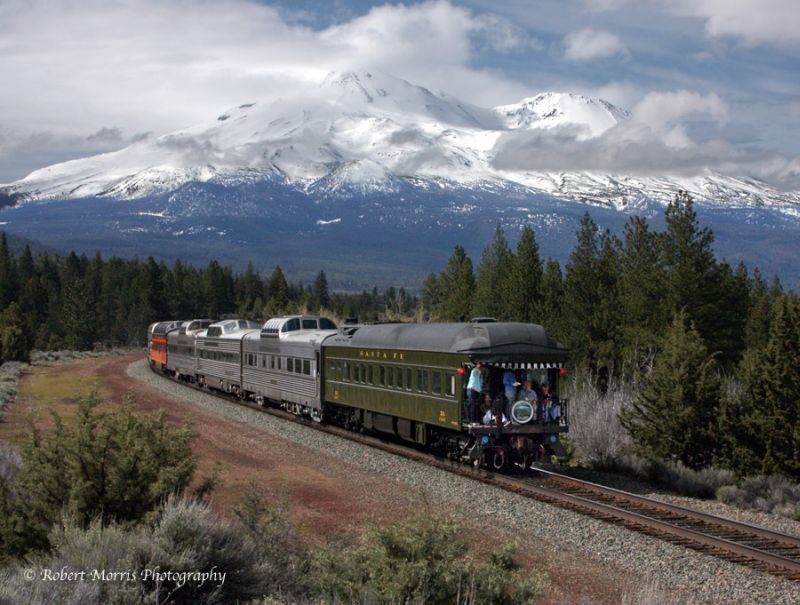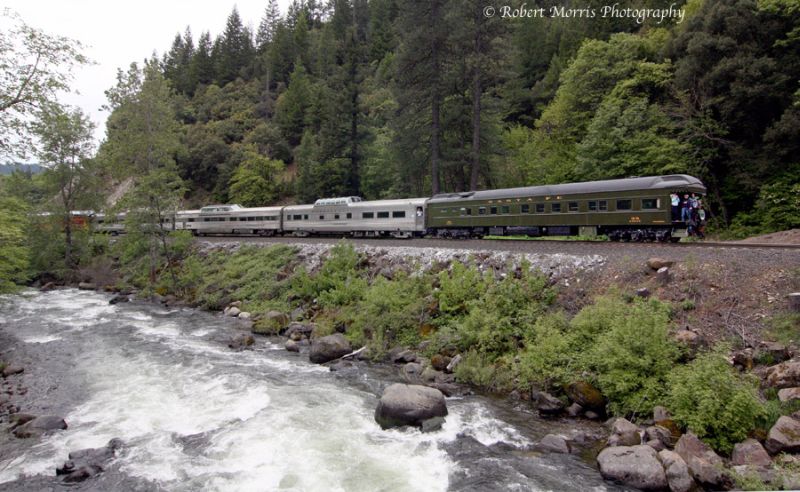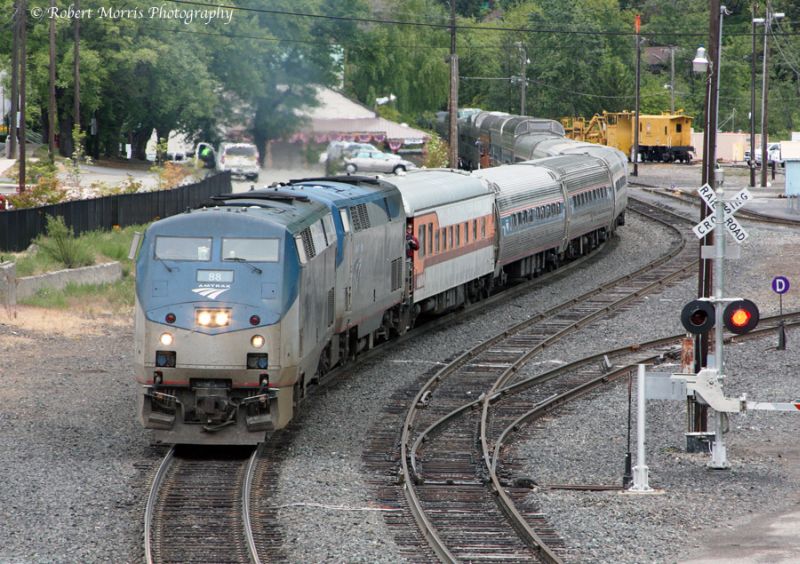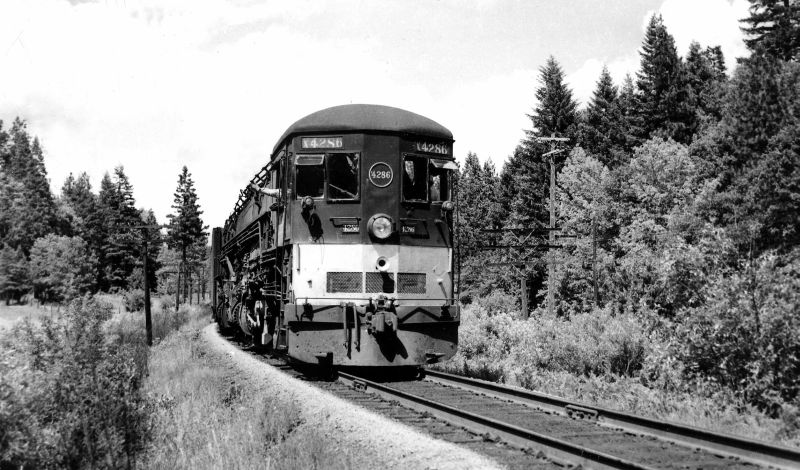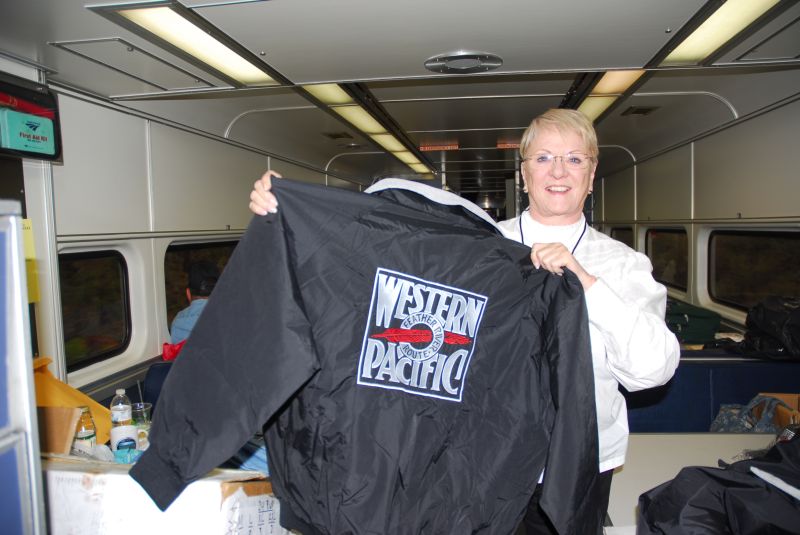Northern California Explorer
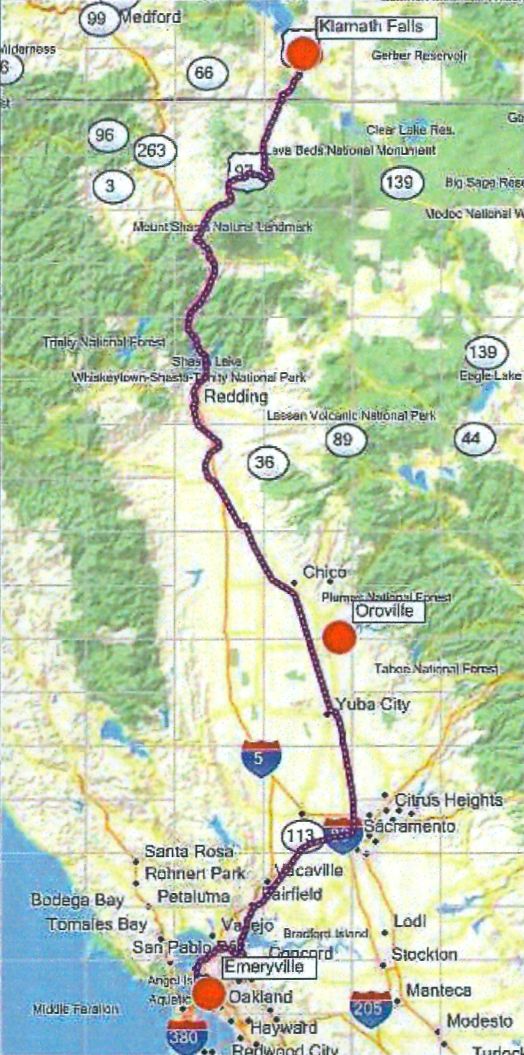
Sunday, June 5, 2011
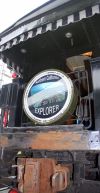 Sunday
morning found the sun trying to peek out from the clouds as excursionists
gathered at the Klamath Falls Amtrak depot for the 8:00 a.m. departure.
Shortly after 8:00 a.m. the excursion train rolled out of town on the ex-SP
Black Butte Subdivision to Dunsmuir. We will follow the route of
Amtrak's Coast Starlight all the way to Emeryville but the territory we
will cover will be viewed by daylight instead of the nighttime passage
of the Coast Starlight.
Sunday
morning found the sun trying to peek out from the clouds as excursionists
gathered at the Klamath Falls Amtrak depot for the 8:00 a.m. departure.
Shortly after 8:00 a.m. the excursion train rolled out of town on the ex-SP
Black Butte Subdivision to Dunsmuir. We will follow the route of
Amtrak's Coast Starlight all the way to Emeryville but the territory we
will cover will be viewed by daylight instead of the nighttime passage
of the Coast Starlight.
At Worden, Oregon we head into the siding to meet the northbound Coast Starlight No.14 At Kegg we pass a southbound UP freight in the siding. Off in the distance snow covered Mount Shasta is in sunlight with its top covered in clouds. The excursion train rolled by the former station of Leaf where Long Bell Lumber Company once had an extensive logging operation off to the east.
Past Grass Lake, the train started the descent into the Sacramento River Canyon. Grass Lake, at an elevation of 5,101 feet, is the highest point on the Shasta Route. At one time helper locomotives were removed from northbound freight trains and returned to Dunsmuir. With high horsepower locomotives and the use of distributed power units on trains, helpers are rare today. From Grass Lake to Black Butte we drop down a 1.4 per cent ruling grade and speed drops to 35 mph.
By the time we reach Black Butte the train is traveling through lava fields. Black Butte has a water tank left over from the steam era and a wye track and interchange tracks with the Central Oregon & Pacific. CORP operates portions of the former SP Siskiyou line between Black Butte and Eugene, Oregon via Ashland, Medford and Grants Pass.
Continuing south, speed picks up to 50 mph passing Upton and Mount Shasta City where interchange was once made with the McCloud River Railroad. Operated as McCloud Railway, the tracks can still be seen heading off to the east.
At Azalea we meet a northbound UP freight train and soon pass the station of Mott and start the descent down the 2.1 per cent grade for the 10 miles into Dunsmuir. Speed drops to 25 mph as we wind through curves and cross the Sacramento River at Cantara. The bridge over the river has been extensively modified with huge steel railings along the sides to prevent any derailed cars from falling into the river. This was the result of the 1991 disastrous derailment SP had when a toxic chemical spilled from a tank car and contaminated the river.
Dunsmuir South
A short stop was made at Dunsmuir at 11:00 a.m. to detrain a passenger. Dunsmuir was once an important rail terminal with a roundhouse and a small yard located at South Dunsmuir. Helper locomotives were added and removed from trains and crews changed. The roundhouse and Cab-Forward engine house are long gone but the turntable remains. Various maintenance of way cars and a Jordan spreader were tied up in the small yard opposite the depot. Closed in 1968, most of the yard tracks at South Dunsmuir have been removed. Freight crews continue to be changed, operating from Roseville to Dunsmuir, a distance of 208 miles, and from Klamath Falls to Dunsmuir, 108 miles.
From Dunsmuir the Northern California Explorer continued its southward journey around curves and along the shore of the fast running Sacramento River. Maximum speed between Dunsmuir and Lakehead is 25 mph for both freight and passenger trains on the 1.2 percent decline.
As the train traveled, bag lunches were distributed to passengers. At Lakehead we join trackage that was opened in 1942 as the result of the construction of Shasta Dam. The original line to the west of the present line has been inundated by the waters of Shasta Lake. The new line has a maximum speed of 65 mph for passenger trains as it heads down a 0.9 per cent grade.
The Sacramento Valley And Home
After crossing the large trestle over the Sacramento River, our train rolls to a short stop at Redding at 12:52 p.m. Redding is the base of a local freight and the turning point for the Roseville-Redding Hauler. Departing Redding we are out of the mountains and traveling through the flat Sacramento Valley. We soon pass through the small community of Anderson where the California Shasta & Eastern Railroad (1891-1927) once connected with the SP.
Continuing southward the train rolled through Cottonwood, climbs a short grade over Hooker hill and passes Red Bluff. Beyond Red Bluff we pass Gerber, once the location of an SP yard. Gerber was the terminal between the Sacramento Division and the Shasta Division and was closed in 1966. Due to the length of our train, a double station stop was made at Chico to detrain passengers.
success with over 600 passengers on board"
Departing Chico at 2:20 p.m., we continue south to Berg where we meet a northbound UP freight, then on to Binney Junction where we switch to the former WP line and retrace Friday's route back to Sacramento. Arrival in Sacramento was at 4:00 p.m. and departure at 4:22 p.m. for the fast run along UP's Martinez Subdivision back to the Bay Area. A short stop was made at Suisun-Fairfield to detrain a passenger, then on to stops at Martinez and Richmond with a final arrival at Emeryville at 6:13 p.m., seven minutes early. This was in plenty of time for South Bay passengers to connect with Capitol Corridor train 747 to San Jose.
More On The Excursion
The excursion was an overwhelming success with over 600 passengers on board. For many years tour groups have been attempting to operate an excursion train over this route. It took a lot of effort by both Central Coast and Trains & Travel International to get Amtrak, Union Pacific and Burlington Northern Santa Fe to approve the trip. While the weather varied between cloudy and light rain, the cooler temperatures made for comfortable conditions in the dome cars that can become very warm when traveling in hot weather.
In an effort to keep on schedule, no photo stops were made. This was critical on the Oroville to Klamath Falls portion of the trip, as under the best of conditions with no delays or meets we would require ten hours. Any delay could have caused the train and engine crew to violate the 12-hour on duty law.
Passengers came from all across the country, some traveling overseas to make this trip. Many were rare mileage collectors taking the opportunity to travel through a remote section of Northern California that few people have the opportunity to see. In addition to camera-toting passengers, the route was lined with motorcaders following the train and taking photos along the route.
This was not the first Central Coast Railway Club excursion over the Inside Gateway. Over the 1956 Labor Day holiday, a three-day trip was operated from Oakland to Wishram, Washington via WP, Great Northern and Oregon Trunk. The portion from Keddie to Bend, Oregon was operated under the cover of darkness.
The Volunteer Crew
Jeff Ferrier, Excursion Director for Central Coast, and Chris Skow, Rail Tours Manager for Trains & Travel International, did an excellent job of overseeing the overall operation of the excursion. Prime managers for the trip were Steve Miller as Train Manager and Stan Hunter as Equipment Manager. Other key managers were Tom Glover as Bus Manager, George Royer as Accomodations Manager, Martin Rice as Communications Manager, Mike Romiez as Reservations Manager, Scott Gerken as Publications Manager and Denis Murchison as Provisions Manager.
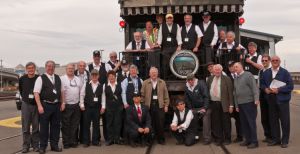 Many
Central Coast members volunteered as car hosts, bus monitors and food handlers.
The list of volunteers putting in long hours to make the trip a success
included Richard Crescitelli, Clem Dickey, Hal Lewis, Arthur Lloyd, and
Debbie Skow. The roster of car hosts included Keith Baker, Barbara Bender,
Henry Bender, Jeff Blackmon, Leigh Bradbury, Chris Cypret, Jim Davidson,
Marilyn Diamond, Tom Diamond, Scott Gerken, Jim Gilmore, Dennis Hanley,
Yorkman Lowe, Jim Maurer, Andy Miller, Denis Murchison, Doug Peterson,
Ken Rattenne, Martin Rice, Ned Rice, Mike Romiez, Joyce Rosenberg, George
Royer, Eric Schatmeier, Bruce Shelton, and Bob Thompson. Many of the car
hosts also handled additional tasks involved with the excursion.
Many
Central Coast members volunteered as car hosts, bus monitors and food handlers.
The list of volunteers putting in long hours to make the trip a success
included Richard Crescitelli, Clem Dickey, Hal Lewis, Arthur Lloyd, and
Debbie Skow. The roster of car hosts included Keith Baker, Barbara Bender,
Henry Bender, Jeff Blackmon, Leigh Bradbury, Chris Cypret, Jim Davidson,
Marilyn Diamond, Tom Diamond, Scott Gerken, Jim Gilmore, Dennis Hanley,
Yorkman Lowe, Jim Maurer, Andy Miller, Denis Murchison, Doug Peterson,
Ken Rattenne, Martin Rice, Ned Rice, Mike Romiez, Joyce Rosenberg, George
Royer, Eric Schatmeier, Bruce Shelton, and Bob Thompson. Many of the car
hosts also handled additional tasks involved with the excursion.
![]()
